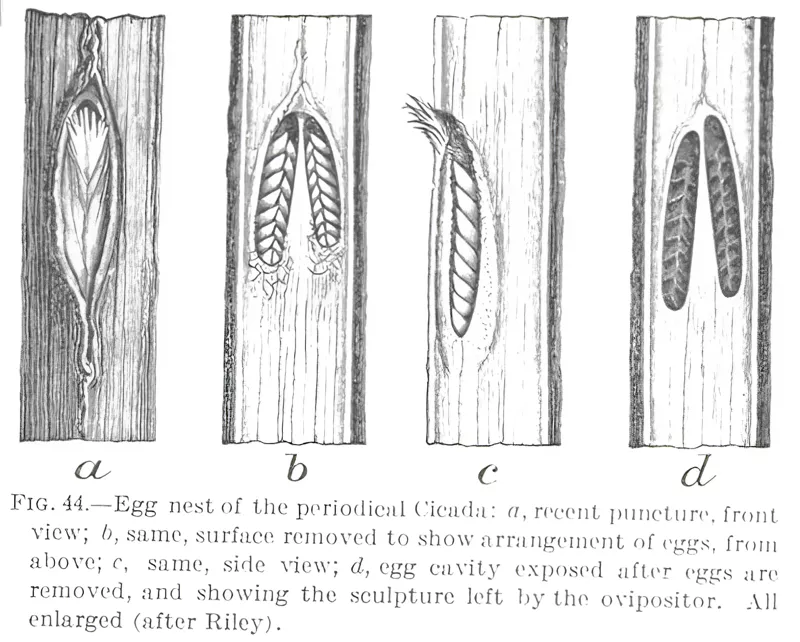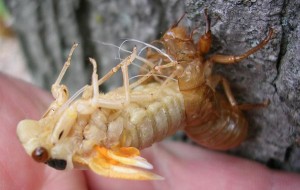One of the most frequently asked questions we receive is: “what do cicadas do“? This question is similar to the question “what is the purpose of cicadas” — the answers to both questions help people understand why these fascinating, unusual creatures exist at all.
The simplest reduction of their life cycle is:
1) They hatch from an egg.
2) They burrow underground where they will drink from plant roots for most of their lives.
3) They leave the underground and become adults.
4) The males make sounds that attract females.
5) Males & females court & mate.
6) Females lay fertilized eggs in the branches of plants, and the cycle continues.
7) They die.
The specifics of a cicada’s life cycle varies from species to species, but here is a more detailed view of what cicadas do:
From egg to 1st instar nymph:
1) Cicada nymphs hatch from eggs.

2) Nymphs feed on plant fluids which they access thanks to the egg-nest groove made by their mothers.
3) They leave the groove, and drift to the ground. Their descent to the ground doesn’t hurt them because they weigh so little.
4) Once on the ground, they dig into the soil until they find small rootlets, from which they will feed.
Once Underground:
5) Underground, they will tunnel/dig…
6) and establish a cell…
7) from where they’ll comfortably feed. Cicadas feed on the xylem sap of plants. With the help of bacteria they transform the water, minerals and amino acids found in tree fluids to the tissues of their own bodies.
8) They pee, in fact they seem to use excess plant fluid to moisten soil to help mold the walls of their cells.
9) Throughout their life underground they will move from root to root… as plant root systems change with the seasons, when roots die off, or perhaps to avoid predators.
10) Underground, a cicada may (depending on the species) go through four instars, molting three times (see an image of the four instars).
Preparing to emerge:
11) Cicadas will build a tunnel to the surface of the ground, in preparation for their emergence.
12) Cicadas often take that a step further an build a chimney/turret above ground. This often happens in shady areas or when the ground is muddy.
Once above ground:
13) They emerge from their tunnels…
14) Cicadas run as fast as they can…
15) And find a surface perpendicular to the ground, hold tight, and begin to molt…
16) During the molting process (ecdysis), cicadas perform many acrobatic moves to separate themselves from their nymphal skin, including pulling their old trachea from their bodies.

17) Once outside their nymphal skin, they will inflate their wings…
18) … and expand various parts of their bodies, like their heads.
19) They will change color.
20) Once their bodies are hard enough (sclerotization counts as a thing they do)…
21) They will either seek shelter, perhaps by crawling up higher along a tree trunk…
22) or if your are a Magicicada, you might stick around in the hopes that a predator will eat you.
Mating and Reproduction:
23a) If you are a Male cicada, you are going to sing… unless you belong to a species that cannot sing, in which case, you’ll move your wings in a way that will produce a sounds.
There are many types of songs: a) distress calls, b) calls to establish territory, c) calls to attract females, d) including choruses of many cicadas and e) courting calls
23b) Female cicadas, and some male cicadas, move their wings to make sounds, also in an effort to attract and engage a mate.
24) Most cicadas (aside from Magicicada during the early days of their adult lives) will try to avoid being eaten by predators.
25) They’ll fly, of course.
26) Cicadas, like Magicicada, will establish chorusing centers, which are places where the male cicadas sing together and females come to meet them.
27) Male and female cicadas will court…
28) and mate…
29) the female cicada will lay her eggs in grooves (ovipositing) she etches into a suitable plant stem, and we’re back to step 1.
30) The last thing cicadas do, of course, is die, and return the nutrients found in their bodies to the soil, where they will be broken down and absorbed by the plants they fed upon.
Some things cicada do not do:
Here are some things cicadas do not do:
1) They don’t seek shelter during the fall months (i.e. they don’t try to live inside your house), unlike Ladybugs or Stinkbugs.
2) They don’t sting or otherwise pass venom onto people.
3) They don’t chew plant leaves, like caterpillars or grasshoppers.
4) They don’t dump garbage in the ocean.
10 replies on “30 Things Cicadas Do”
We have holes in the ground also.they seem partial to my white potatoe leaves.they have munch quite a lot. Last night they started coming to the house.making noises. What’s going on. WHEN DO THEY LEAVE.
3-4 weeks.
will females cicadas lay eggs in human skin?
Perchance to dream. No, just tree branches.
We have found the holes in our yard. And we are having large patches of our grass to die. Could the cicadas be causing this?
Probably not cicadas killing your grass. Once they leave, via the hole, they don’t go back in.
There are currently gazillions of cicadas and their cast off outer skins on my property in Southwest Virginia. It’s both creepy and astonishing. The noise sometimes drives me close to insanity. It sounds like a continuously running outdoor sawmill. It’s good to know that they do not destroy the plants or trees.
Fascinating Site. Thanks for the info. I’ve seen hundreds at the trunk of each tree on a few golf courses in western PA starting on May 23rd 2019. My home is surrounded by woods and you can hear them nonstop, but I haven’t seen a single one around the few trees in my back yard. They’re actually quite cute if you look at them closely and when you pick them up they death grip you with their feet.
It’s about 500 of these creepy bugs round our apartment building but there is a lot of trees around they are all around our building all over our window it was hard for us to even get in out building because they was surrounding it. it’s so scary . They been around since May so hopefully they will be gone very soon
Hahaha, touche (#4). I always try to remember that the creepier a critter looks to me, the creepier I must look to it. Imagine if cicadas had to describe humans: “They live above ground for up to 100 years, and their litter lasts even longer! And there are billions of them!”
It’s June 2, 2016, and the cicadas are creating an unholy mess and racket around our house, but they should be mostly gone by the 4th of July. Something to look forward to, gratefully!